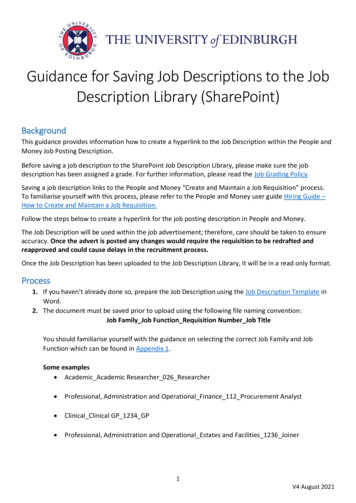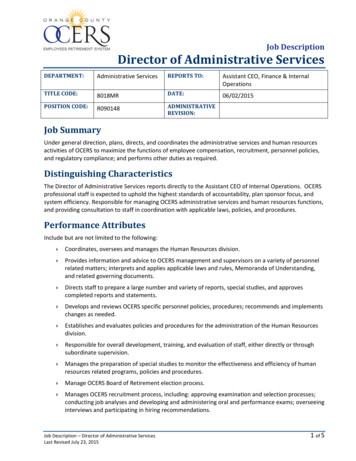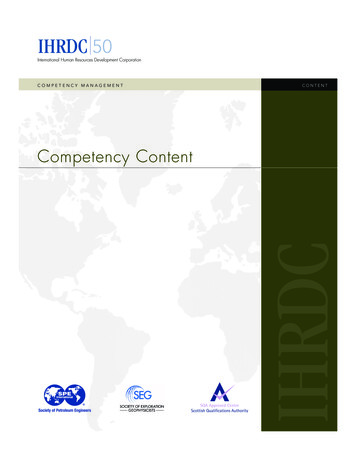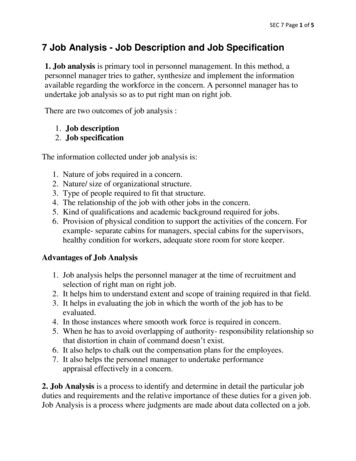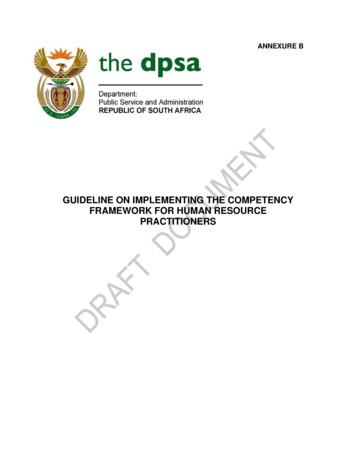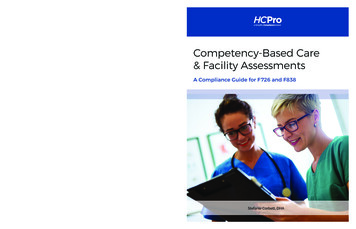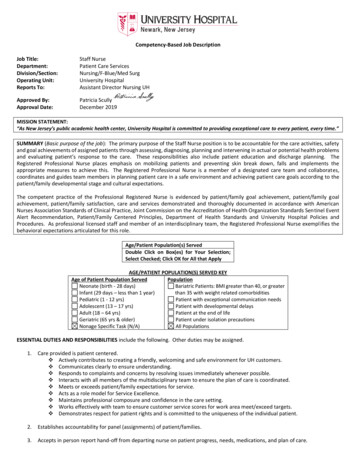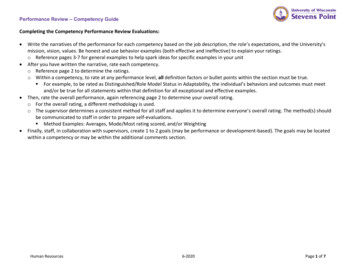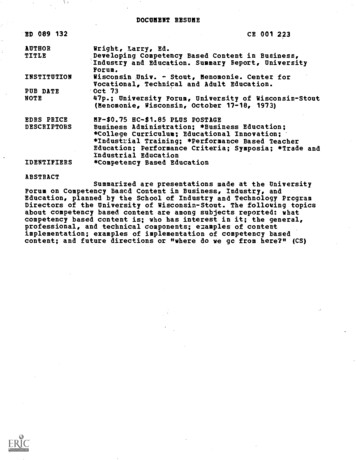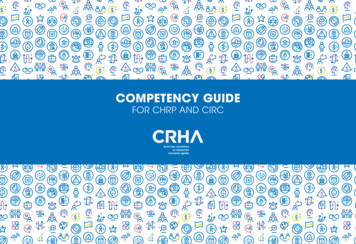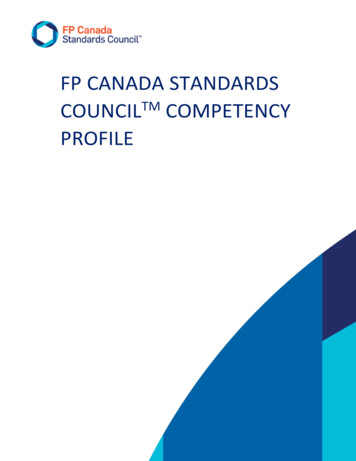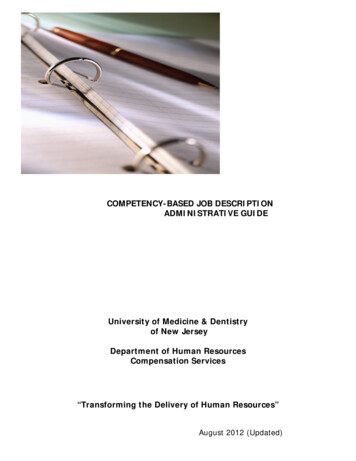
Transcription
COMPETENCY-BASED JOB DESCRIPTIONADMINISTRATIVE GUIDEUniversity of Medicine & Dentistryof New JerseyDepartment of Human ResourcesCompensation Services“Transforming the Delivery of Human Resources”August 2012 (Updated)
TABLE OF CONTENTSCompetency-Based OverviewPage 3Competency-Based Job Description Template(With Basic Instructions)Page 4Competency-Based Job Description Instructions(With Detailed Instructions)Page 6Next Steps . . . Competency Validation ProcessPage 9AddendumPage 10The Joint Commission (TJC) – Human Resources StandardsAmerican Disabilities ActADA Physical Demands Documentation Check Off ListADA Work Environment Documentation Check Off ListCompetency-Based Job Description SamplesClinical – Supervising Advanced Practice NurseNon-Clinical – Data Control Clerk IJoint Commission on Accreditation ofHealthcare OrganizationsSetting the Standard for Quality in Health CareBrochure2
OVERVIEWThe Competency-Based Job Description Administrative Guide provides step-by-step instructions for completing a Competency-BasedJob Description. Job descriptions serve as the foundation of a quality competency program and provide the starting point for thisprocess. While often considered a tedious task, a well-researched and written job description serves as the basis of control in thehiring and performance evaluation processes. It should be used to guide the orientation process. The Joint Commission requireshospitals to have a process to ensure that a person’s qualifications are consistent with their responsibilities. This requirement isdirected at staff and students and includes volunteers that work in the same capacity as staff that provide patient care, treatment,and services. Job descriptions that are competency-based are the cornerstone in meeting these expectations. Leaders of theorganization are expected to define the required competence and qualifications of staff. 1Developing a Competency-Based Job Description is the first basic step to competency validation. A Competency-Based JobDescription should include the primary responsibilities/essential duties of the job, qualifications, primary source verification andpatient populations to whom care is to be delivered (if applicable) must be defined clearly in the job description as well as physicaldemands, work environment and other duties as assigned.1The Joint Commission defines Competency as the demonstrated ability to carry out the primary responsibilities of the job. Theprimary responsibilities of the job should be indicated in the “essential duties and responsibilities section” of the job description.Competency-Based validation ensures each employee possesses the skills identified in the job description and adequately performsthe essential duties.Compliance with these guidelines and other regulations affecting employers ensures that we have addressed The Joint Commissionand should any ADA issue arise.Organization’s ResponsibilityOrganizations must assess all staffs’, students’ and volunteers’ ability to meet performance expectations as stated in the jobdescription. Competency validation at the time of hire is a process of ensuring that an individual is qualified to enter the worksite. Itis incumbent on the organization to ensure that he or she meets the qualifications stated in the job description.Competency Assessment Compliance Tip: Avoiding The Joint Commission citations in the area of competency assessment begins withthe job description itself, which should clearly delineate the qualifications for the job.2See Addendum containing The Joint Commission’s Human Resources Standards, for ADA compliance - Physical Demands and WorkEnvironment Check Off Lists, and The Joint Commission on Accreditation of Healthcare Organizations - Setting the Standard forQuality in Health Care Booklet.Contacts:Donna H. Wlodarski, Compensation Services Specialist at973-972-2452 – Primary Point of Contact for Competency-Based Job DescriptionsDoreen J. Pringle, Senior Compensation Services Associate at732-235-9411 for New Brunswick/Piscataway/Scotch Plains/Stratford/Camden CampusesDelzal B. Moss, Director of Compensation and Benefits Services at973-972-4845Need to know more about Compensation? We encourage you to visit our new, innovative website designed to meet all of yourCompensation needs at: www.umdnj.edu/hrweb/tools.“Our goal is to provide you with excellent customer service to meet the needs of your organization.”1Competency Assessment: A Practical Guide to the JCAHO Standards, Second Edition, page 39.2Competency Assessment: A Practical Guide to the JCAHO Standards, Second Edition, page 21.3
Competency-Based Job DescriptionTemplateGo to Competency-Based Job Description Template.University of Medicine and Dentistry of New JerseyCompetency-Based Job DescriptionJob Title:Department:Division/Section:Operating Unit:Reports To:Approved By:Approved Date:Fill In UMDNJ Job TitleFill In DepartmentFill In Division/Section If ApplicableUniversity HospitalFill In UMDNJ Title That This Position Reports ToFinal Job Descriptions Must Be Approved by Compensation Services – Human ResourcesDate Job Description is Approved by Compensation ServicesMISSION STATEMENT:“To improve the quality of life for all those we touch through excellence in patient care, education, research and communityservice."SUMMARY (Basic purpose of the job):The primary purpose of the Fill in UMDNJ Job Title position is toAge/Patient Population(s) ServedDouble Click on Box(es) for Your Selection;Select Checked; Click OK for All that ApplyAGE/PATIENT POPULATION(S) SERVED KEYAge of Patient Population ServedNeonate (birth - 28 days)Infant (29 days – less than 1 year)Pediatric (1 - 12 yrs)Adolescent (13 – 17 yrs)Adult (18 – 64 yrs)Geriatric (65 yrs & older)Nonage Specific Task (N/A)PopulationBariatric Patients: BMI greater than 40, or greaterthan 35 with weight related comorbiditiesPatient with exceptional communication needsPatient with developmental delaysPatient at the end of lifePatient under isolation precautionsAll PopulationsESSENTIAL DUTIES AND RESPONSIBILITIES include the following. Other duties may be assigned. (List Essential Duty ResponsibilityStatements.) Core Competency is the demonstrated ability to carry out the primary responsibilities of the job which should be reflected in theessential duties section of the job description.1.2.3.4.5.6.7.8. Performs other related duties as assigned.4
UNIVERSITY CORPORATE COMPLIANCE RESPONSIBILITIES(Make Appropriate Selections from the Following and List as Part of the Essential Duties and Responsibilities.)Understands and adheres to UMDNJ's compliance standards as they appear in UMDNJ's Corporate Compliance Policy, Code ofConduct and Conflict of Interest Policy. (To be included in all job descriptions.)Keeps abreast of all pertinent federal, state and UMDNJ regulations, laws, and policies as they presently exist and as they change orare modified. (To be included in all professional, supervisory and managerial job descriptions.)Ensures that the staff are trained and evaluated on their knowledge of and adherence to compliance policies and procedures specific totheir jobs. (To be included in all supervisory and managerial job descriptions.)JOB REQUIREMENTS:To perform this job successfully, an individual must be able to perform each essential duty satisfactorily. The requirementslisted must be representative of the knowledge, skills, minimum education, training, licensure, experience, and/or abilityrequired. Reasonable accommodations may be made to enable individuals with disabilities to perform the essential functions.- Credential Required: (Specify for Clinical Positions)- Primary Source Verification: (Specify for Clinical Positions)(Specify Significant Physical Demands and Work Environment Conditions in the Job Requirements Section. Keep copies of theADA Physical Demands and Work Environment Documentation Check Off Lists in your files.PHYSICAL DEMANDS:WORK ENVIRONMENT:EMPLOYEE ACKNOWLEDGEMENTI, , Acknowledge Review of This Job Description.(Employee’s Name - PRINT Name)Date:Employee’s SignatureDate:Supervisor’s SignatureThis form is available on the CompToolKit as either a Microsoft Word document or pdf file (PDF files can beread/printed with Acrobat Reader). The Competency-Based Job Description should be submitted electronically usingthis Template.5
Competency-Based Job DescriptionInstructionsI.Job Title:Department:Division/Section:Operating Unit:Reports To:Approved By:Approved Date:Fill In UMDNJ Job TitleFill In DepartmentFill In Division/Section if ApplicableUniversity HospitalFill In UMDNJ Title That This Position Reports ToFinal Job Descriptions must be approved by Compensation Services – Human ResourcesDate Job Description is Approved by Compensation ServicesII.MISSION STATEMENT(Specific to each Operating Unit – University Hospital’s Mission Statement is already on Template)III.SUMMARY(Briefly, state the overall job responsibilities in fifty (50) words or less. Refer to the generic job description library for suggested language.Differentiate this job from others in the department. Focus on the central purpose of the job using action verbs such as provides, performs,researches, coordinates and plans. Age/Patient Population(s) Served statements that are specific to the patients receiving care must be includedwithin the job summary of the position.) Feel free to contact Compensation Services if you need examples that are not on the CompToolKit.IV.AGE/PATIENT POPULATION(S) SERVED DEFINITIONThis section should be included in all patient-care job descriptions if appropriate. Identification of the population and ages served within the jobdescription offers the new employee the opportunity to assess his/her skills and desire to work with the age and population defined. Competency as itrelates to various age-specific components of assessing, evaluating, treating, and providing care to patients is The Joint Commission’s expectation.Select the appropriate age related or population related code. There may be more than one code in the Key that you select. Be inclusive of allpopulations served in your Key selection. The Age/Patient Population Served Key corresponds with the Competency-Based Template’s Key. Placean “X” in the box(es) for all that apply.Example I: C – Pediatric (1-12 yrs)Example II: M – All Populations)Age/Patient Population(s) ServedDouble Click on Box(es) for Your Selection;Select Checked; Click OK for All that ApplyAGE/PATIENT POPULATION(S) SERVED KEYAge of Patient Population ServedNeonate (birth - 28 days)Infant (29 days – less than 1 year)Pediatric (1 - 12 yrs)Adolescent (13 – 17 yrs)Adult (18 – 64 yrs)Geriatric (65 yrs & older)Nonage Specific Task (N/A)PopulationBariatric Patients: BMI greater than 40, or greaterthan 35 with weight related comorbiditiesPatient with exceptional communication needsPatient with developmental delaysPatient at the end of lifePatient under isolation precautionsAll Populations6
V.ESSENTIAL DUTIES AND RESPONSIBILITIES(List the top eight (8) or ten (10) critical duties in order of importance and frequency that must be performed by the incumbent. When consideringthese critical duties, focus on what must be accomplished within the department. Duties performed less frequently should be included towards theend of the list.) These should be the essential duties that are required in order for the employee to perform the task satisfactorily.Integrate responsibility and expected practice. Define those tasks that are necessary to the fulfillment of the position. Talk with employees that arecurrently serving in the role to ensure the job description and requirements match the actual job.3VI.PERFORMS OTHER RELATED DUTIES AS ASSIGNEDEstablish the premise that the job‘s essential duties list is not all inclusive, and other functions may be added dependent upon certain situations.Include expectations such as committee membership, required education/classes, and preceptorship as appropriate.VII.ADA COMPLIANCE1. Essential Duties of a Position: The essential duties of a position are defined by ADA as job duties that are so fundamental to the position that theindividual cannot do the job without being able to perform them. A function is considered to be essential if the performance of this function is thereason the job exists, there are a limited number of other employees who could perform the function, or if the function is specialized and theincumbent is hired on the basis of his or her skill/ability to perform the function.2. Employer’s Judgment: ADA gives consideration to the employer’s judgment as to what functions of a position are essential. A written jobdescription is considered evidence of the essential duties of the position and should be developed before advertising or interviewing applicants forthe position.3. Reasonable Accommodation: ADA requires employers to provide reasonable accommodation to qualified individuals with disabilities who areemployees or applicants for employment unless this would cause an undue hardship. The employee still has his or her responsibility to be able toperform the essential duties of the position. “Undue Hardship” means significant difficulty or expertise would be incurred and focuses on theresources and overall circumstances of the employer in terms of the cost or difficulty in providing a specific accommodation.VII.CORPORATE COMPLIANCE RESPONSIBILITIES(Must be on All Job Descriptions; make appropriate selections from the following and list as part of the Essential Duties and Responsibilities.)Understands and adheres to UMDNJ’s compliance standards as they appear in UMDNJ’s Corporate Compliance Policy, Code of Conduct andConflict of Interest Policy. (To be included in all job descriptions.)Keeps abreast of all pertinent federal, state and UMDNJ regulations, laws, and policies as they presently exist and as they change or are modified.(To be included in all professional, supervisory and managerial job descriptions.)Ensures that the staff are trained and evaluated on their knowledge of and adherence to compliance policies and procedures specific to their jobs.(To be included in all supervisory and managerial job descriptions.)VIII.JOB REQUIREMENTSIndicate the Minimum Requirements to Perform the Essential Duties of the Position in this section. (Indicate Minimum Education and/orExperience; Legal Compliance for Clinical Positions, any significant Physical Demands specifics or Work Environment Conditions in this section.)Consider the specific knowledge, skills and abilities required to perform the essential duties successfully. Relate each required qualification such aseducation and/or experience, computer application skills and communication skills, to the job and not the previous incumbent. Work Environmentconditions impacting the job should be typed in the Template. The job requirements section of the job description consists of the following threecategories. Fill in the appropriate information in this section.3Competency Assessment: A Practical Guide to the JCAHO Standards, Second Edition, page 40-41.7
JOB REQUIREMENTS:To perform this job successfully, an individual must be able to perform each essential duty satisfactorily. The requirementslisted must be representative of the knowledge, skills, minimum education, training, licensure, experience, and/or abilityrequired. Reasonable accommodations may be made to enable individuals with disabilities to perform the essential functions.1.EDUCATION and/or EXPERIENCE/QUALIFICATIONS(Refer to the Human Resources Compensation Services CompToolKit for Assistance.) The qualifications should be consistent with the employee’sjob responsibilities.)42. LEGAL COMPLIANCE FOR CLINICAL POSITIONSRequired for employees who occupy a clinical position to ensure the Legal requirements of the position are specified as well as Compliance withJoint Commission’s regulations and HR standards.Credential requirements and Primary Source Verification should be indicated in the job requirements section of the job description and is importantfor The Joint Commission Compliance. The department head is responsible for defining the required qualifications and ensuring legalcompliance in terms of credentials and updating requirements with Compensation Services when the regulations change. Current credentials arerequired for all practitioners requiring a license, certification or registration to perform their job responsibilities. When current licensure,certification, or registration is required by law or regulation to practice a profession, it is the responsibility of the hospital’s leadership to verifythese credentials with the primary source at the time of hire and upon expiration of the credentials.*5 All operating units who employ licensed,registered or certified professionals are responsible for verifying these credentials through primary source verification (certifying agencies) inaccordance with state & other regulating agency’s regulations. Job requirements for these clinical positions must indicate the “specific current andactive licensure, registration or certification” required “which must be maintained in good standing.” The practitioner will be responsible formaintaining the credential indicated in the requirements of the position, with the issuing/certifying agency. The operational unit is responsible formonitoring expiration dates and requesting a written “primary source” verification with the above stated agency no later than the expiration date oflast primary source verification performed. “Healthcare professionals” include individuals licensed or authorized to practice a healthcare professionregulated by DCA (Division of Consumer Affairs) and other professional and occupational licensing boards including physicians; podiatrists; nurses;pharmacists; physical, occupational and respiratory therapists; nurses aids and personal assistants; psychologists; psychoanalysts; social workers;speech and language pathologists; optometrists; opticians; dentists; orthotics and prosthetic providers; marriage and family therapists; veterinariansand chiropractors; and acupuncturists. When the hospital requires current licensure, certification, or registration that are not required by law orregulation, the hospital should verify the credential at the time of hire and upon expiration of the credential. The Director of Regulatory Affairsshould be consulted with as required.PRIMARY SOURCE VERIFICATION and CREDENTIALS REQUIRED MUST BE INCLUDED IN THE JOBREQUIREMENTS SECTION OF THE JOB DESCRIPTION IF APPLICABLE:IE.- Credential Required: Licensed as a Registered Nurse- Primary Source Verification: N.J. Division of Consumer Affairs, Board of Nursing3.PHYSICAL DEMANDSPhysical Demands required to perform the Essential Duties of the Position. (The requirements of the job description should denote physical demandsfor ADA Compliance that would affect the ability to perform the job. Specify Physical Demands that may affect job performance in the requirementssection of the job description. (See Physical Demands Addendum).WORK ENVIRONMENTSpecify Significant Work Environment conditions in the job requirements. Keep copies of the ADA Physical Demands and Work EnvironmentDocumentation Check Off Lists in your files.IX.EMPLOYEE ACKNOWLEDGEMENTEmployee acknowledgement is required for all Operating Units who have The Joint Commission Review for Accreditation. Employee mustacknowledge receipt of his/her job description and a copy must be given to the employee. Supervisors are responsible for maintaining a signedcopy for their records. When job descriptions are revised and approved by Compensation Services, a copy also must be given to the employee andacknowledged.I, , Acknowledge Review of This Job Description.(Employee’s Name - PRINT Name)Date:Employee’s SignatureDate:Supervisor’s Signature4Comprehensive Accreditation Manual for Hospitals: The Official Handbook Update 2, May 2005, page HR-2.*Effective January 1, 2006Comprehensive Accreditation Manual for Hospitals: The Official Handbook Update 2, May 2005, page HR-7.58
NEXT STEPS COMPETENCY VALIDATION PROCESSSTEP 1:Develop your Competency-Based Job Description.STEP 2:Review the essential duties that you have outlined in the job description.STEP 3:Use the competency validation template to establish core and ongoing competencies for staff by specific job title. Core competenciesmust be validated during the orientation period to assess if the staff has the demonstrated ability to carry out the primaryresponsibilities of the job.STEP 4:It is then necessary to validate staff competency during orientation and thereafter on an ongoing basis after orientation is completed.Competency validation is the process used by the organization to ensure staff possess the skill set identified in their job descriptionand safely perform the tasks or activities for their position according to established hospital standards. Ongoing competencies mustbe validated on an ongoing basis to assess aspects of the job that are mandated, low volume or high risk, problem prone and new orchanged to ensure the staff is competent to perform them.STEP 5:Use the current Performance Evaluation until the Competency-Based Performance Evaluation is developed by the Project Team.Leaders should complete the evaluations with the frequency established in organizational policy and address the employee’s ability tomeet performance expectations stated in his/her job description (for example, adherence to organization-wide and departmentalpolicies, professional standards, etc.)Surveyors expect a competency validation process that includes all employees not just those in clinical positions. They expect to see aprocess that validates the ability of staff providing care, treatment, or service to patients of different ages and different populationgroups to do this in a way that is appropriate to the ages and populations of the patients to whom they provide the care, treatment, orservice. Age-specific competency validation should reflect the actual care given. Generalized approaches to validating ageappropriate care concepts, with no clear delineation of what this care actually entails or how it actually differs for the various agegroups or populations, are no longer sufficient. Surveyors expect to see the methodology used to validate competency and not place acheck mark next to the competency or state that the employee provides age-appropriate care without supporting evidence.6SURVEYORS’ EXPECTATIONSSurveyors are looking for the following: 67Current job descriptionEvidence of orientation, if hired after 1992Competency validation, both at the end of orientation and ongoing competency validationCompleted performance reviewEvidence of current licensure/registration/certification, if required for the job (as a performance expectation)Continuing Education7Competency Assessment: A Practical Guide to the JCAHO Standards, Second Edition, page 75.Competency Assessment: A Practical Guide to the JCAHO Standards, Second Edition, page 74.9
Addendum10
Human Resources StandardsThe following is a list of all the standards. They are presented here for your convenience withoutfootnotes or other explanatory text.PlanningHR. 1.10The hospital provides an adequate number and mix of staff that are consistent with thehospital’s staffing plan.HR.1.20The hospital has a process to ensure that a person’s qualifications are consistent with hisor her job responsibilities.HR.1.30The hospital uses data from clinical/service screening indicators and human resourcescreening indicators to assess and continuously improve staffing effectiveness.Orientation, Training, and EducationHR.2.10Orientation provides initial job training and information.HR.2.20Staff members, licensed independent practitioners, students, and volunteers, asappropriate, can describe or demonstrate their roles and responsibilities, based on specificjob duties or responsibilities, relative to safety.HR.2.30Ongoing education, including in-services, training, and other activities, maintains andimproves competence.Competence AssessmentHR.3.10Competence to perform job responsibilities is assessed, demonstrated, and maintained.HR.3.208The hospital periodically conducts performance evaluations.8Comprehensive Accreditation Manual for Hospitals: The Official Handbook Update 2, May 2005, page HR-2.11
Job Title:Date:PHYSICAL DEMANDS DOCUMENTATION CHECK OFF LISTMaintained in Department File OnlyRequired:Documentation in a job description to accurately reflect the essential duties of the job and physical demands.Specify Significant PHYSICAL DEMANDS for the Job Requirements:Clarify how much on-the-job time is spent on the physical activities required to perform the job effectively.Use the chart below to develop your description of physical demands by checking the appropriate boxes.1. How much daily/weekly on-the-job time is spent on the following physical activities?Amount of TimeNoneUnder Up To Over1/32/32/3StandWalkSitUse hands to finger, handle, or feelReach with hands and armsClimb or balanceStoop, kneel, crouch, or crawlTalk or hearTaste or smell2. Does this job require that weight be lifted or force be exerted? If so, how much and how often?Amount of TimeNoneUnder Up To Over1/32/32/3Up to 10 poundsUp to 25 poundsUp to 50 poundsUp to 100 poundsMore than 100 pounds3. Does this job have any special vision requirements?Close vision (clear vision at 20 inches or less)Distance vision (clear vision at 20 feet or more)Color vision (ability to identify and distinguish colors)Peripheral vision (ability to observe an area that can be seen up and down or to the left and right whileeyes are fixed on a given point)Depth perception (three-dimensional vision, ability to judge distances and spatial relationships)Ability to adjust focus (ability to adjust the eye to bring an object into sharp focus)No special vision requirementsSpecify the essential job duties that require the physical demands indicated above.i.e., Position requires standing 1/3 of the time.i.e., Position requires lifting 1/3 of the time up to 10 pounds.Any special physical demands should be clearly communicated to any applicant applying for this position and allemployees occupying this position.12
Job Title:Date:WORK ENVIRONMENT DOCUMENTATION CHECK OFF LISTMaintained in Department File OnlyRequired:Documentation in a job description to accurately reflect the essential duties of the job and work environment.Specify Significant WORK ENVIRONMENT for the Job Requirements:Clarify how much on-the-job time work environment conditions are required to perform the job effectively.Use the chart below to develop your description of work environment by checking the appropriate boxes.1. How much daily/weekly exposure to the following environmental conditions does this job require?Amount of TimeUnder Up To OverNone 1/32/32/3Wet or humid conditions (non-weather)Work near moving mechanical partsWork in high, precarious placesFumes or airborne particlesToxic or caustic chemicalsOutdoor weather conditionsExtreme cold (non-weather)Extreme heat (non-weather)Risk of electrical shockRisk of radiationVibration2. How much noise is typical for the work environment of this job?Very quiet conditions (examples: forest trail, isolation booth for hearing test)Quiet conditions (examples: library, private office)Moderate noise (examples: business office with computers and printers, light traffic)Loud noise (examples: metal can manufacturing department, large earth-moving equipment)Very loud noise (examples: jack hammer work, front row at rock concert)Specify the essential job duties that require the work environment conditions indicated above.Any special work environment and/or safety conditions should be clearly communicated to any applicant applyingfor this position and all employees occupying this position.13
University of Medicine and Dentistry of New JerseyCompetency-Based Job DescriptionJob Title:Department:Division:Operating Unit:Reports To:Approved By:Approved Date:Supervising Advanced Practice NursePatient Care ServicesEmergency DepartmentUniversity HospitalDirector, Patient Care ServicesDBMMay 2011MISSION STATEMENT:“To improve the quality of life for all those we touch through excellence in patient care, education, research andcommunity service."SUMMARY (Basic purpose of the job):The primary purpose of the Supervising Advanced Practice Nurse position is to serve as an expert in the delivery of emergencynursing care. Utilizes advance practice nursing expertise in the provision of care to emergency patients, staff orientation and ongoingstaff development. Directs and supervises professional and paraprofessional staff members within the Emergency Department.Maintains a clinical track faculty appointment and serves as a preceptor for students.Age/Patient Population(s) ServedDouble Click on Box(es) for Your Selection;Select Checked; Click OK for All that ApplyAGE/PATIENT POPULATION(S) SERVED KEYPopulationBariatric Patients: BMI greater than 40, or greaterthan 35 with weight related comorbiditiesPatient with exceptional communication needsPatient with developmental delaysPatient at the end of lifePatient under isolation precautionsAll PopulationsAge of Patient Population ServedNeonate (birth - 28 days)Infant (29 days – less than 1 year)Pediatric (1 - 12 yrs)Adolescent (13 – 17 yrs)Adult (18 – 64 yrs)Geriatric (65 yrs & older)Nonage Specific Task (N/A)ESSENTIAL DUTIES AND RESPONSIBILITIES include the following. Other duties may be assigned. (List Essential Duty ResponsibilityStatements.) Core Competency is the demonstrated ability to carry out the primary responsibilities of the job which should be reflected in theessential duties section of the job description.1.Provides advanced practice nursing ex
The Competency-Based Job Description Administrative Guide provides step-by-step instructions for completing a Competency-Based Job Description. Job descriptions serve as the foundation of a quality competency program and provide the starting point for this process. While often considered a tedious task, a well-researched and written job .
